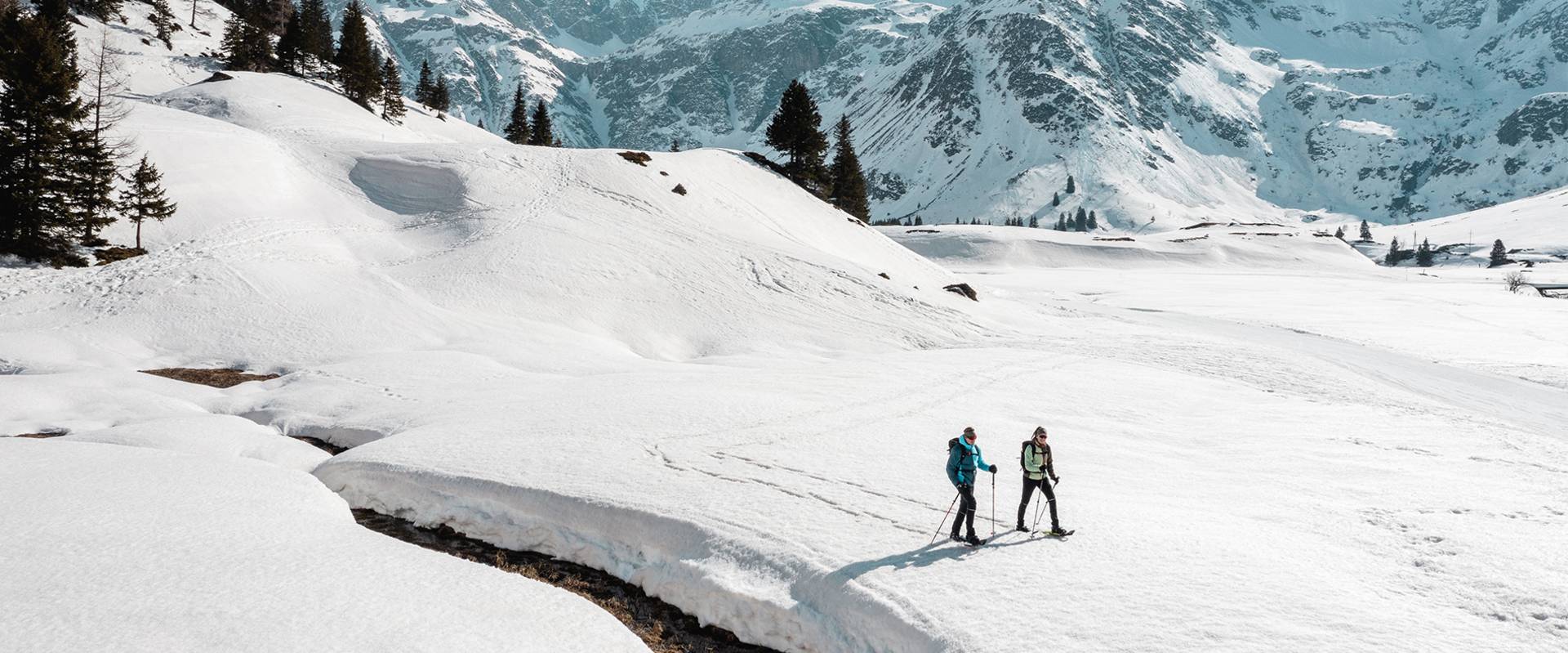
Snowshoeing is a slower way to approach the mountains in the winter. You don’t stand in crowds at the lift and you also don't whizz down the slope, instead you walk steadily though the snowy winter landscapes and so you also witness much more of the surroundings. And all of that without the crowds, just the sound of crunching snow underfoot. Snowshoeing is also a wonderful way to move in the winter. You don't need any prior knowledge and you learn the movement quickly. The equipment needed for it is cheaper than the equipment for skiing and can be rented in many ski resorts. We want to answer the most important questions about snowshoeing with children.
There are already snowshoes for little kids aged 3 and over, but they are more for trying out in the garden. The little ones do not have particularly great stamina yet. However, from five years old you can already start little snowshoe hikes.
Snowshoeing isn’t rocket science, because anyone who can walk, can also snowshoe! However, there are some tips that will put you in a better position and that you should pass on to your kids. Once you have the right age-appropriate model on your feet (ideally also with poles), you can get started. It is best to begin practising on the flat.
- TIP 1: You actually walk completely normally as you would with hiking boots. Except if the ground is icy and the incline is greater, in which case you should only lift your foot when the other has found a hold with the claws in the ice.
- TIP 2: You don't have to raise the snowshoe properly or walk with your legs apart, shuffling is also allowed.
- TIP 3: If the snow is deeper and the incline is greater, then turn your toes slightly outwards. This makes it easier to go upwards.
- TIP 4: If it gets even steeper, you can turn the stirrups down.
- TIP 5: When going down, you can sometimes slip a little despite the claws. Simply walk in a slightly supine position and lift your knee slightly with every step, then you will be able to descend without any problems.

It is quick and easy to adjust, has a firm grip and is equipped with a heel lifter, a rolling aid and 3D-shaped side rails for better grip when traversing. Recommended for children from nine to 14 years with shoe sizes of approximately 34 to 44.
Snowshoes enlarge the sole surface area, through which the weight is extensively distributed, meaning you hardly sink into the snow. In general, we distinguish between Originals (traditional), Classics (all-rounder) and Moderns (more sophisticated). For children, there are particular shoes which are adjusted to weight and height. The binding of these shoes is flexibly adjustable and “grows” with them. Children’s snowshoes are mostly made of plastic. From eight years old, aluminium variants begin. It is best to buy the poles at the same time. Don’t forget powder snow baskets! These are wider than standard baskets and prevent you from sinking in deep snow.
The prerequisites for the shoe in the snowshoe are waterproofness and a stiff sole. The shoes should keep you warm and reach over the ankles. Snowboard boots are also suitable for this.
It is not only adults who work up a sweat when snowshoeing. Therefore the children’s clothing should not only be warm, but also functional, breathable and waterproof. So several layers, as per the ‘onion principle’. Gaiters are recommended to stop snow getting into the shoes!

- Provisions (in addition to food, a thermos flask with a warm drink)
- Mobile phone, money
- Sun protection and sunglasses
- First aid kit
- Avalanche transceiver and shovel (for high alpine terrain)
- A change of clothes
Don’t choose tours for children that are too challenging, and always allow for breaks and stopping points. The tour should not contain any danger points such as crossing ski slopes or toboggan runs, avalanche areas, or wildlife protection zones. If you are unsure, it is better to hire a guide.
